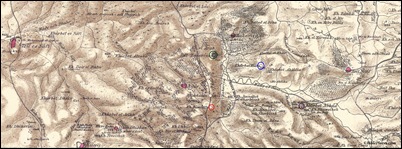Gershon Galil has proposed in a message posted on ANE-2 that Khirbet Qeiyafa should be identified with biblical Netaim. You can read the entire message on the list, but he summarizes as follows:
So in my opinion Khirbet Qeiyafa is Neta‘im for three main reasons: (a) it is located near Gederah; (b) its name is preserved in Khirbet En-Nuweiti‘; (c) it was inhabited only in the 10th century. That is why Neta‘im is not mentioned in the list of the cities of Judah in Josh. 15, which is dated to the 8th or 7th century BCE.
Netaim is mentioned only in 1 Chronicles 4:23, and not much can be deduced from this passage. It’s apparent that Netaim is in the territory of Judah, may or may not be located in proximity to Gederah, and was home to a group of royal potters.
1 Chron 4:23 (ESV) These were the potters who were inhabitants of Netaim and Gederah. They lived there in the king’s service.
That’s not a lot to go on. I’m probably less inclined to believe that the name of Netaim was preserved 2 miles (3 km) away, as Galil proposes. That’s a long distance in the densely occupied Iron Age Shephelah.
Galil has previously offered his translation of the Qeiyafa Ostracon, and he concludes his message by relating his identification to the inscription.
This new identification indicates that Khirbet Qeiyafa/ Neta‘im was inhabited by potters who worked in the king’s service. In the same city, a member of a family of scribes (probably also in the king’s service), wrote the Qeiyafa inscription, the most ancient and important Hebrew inscription ever found:
[……] (1′) do not do (it), but worship […].
(3′) Judge the slave and the widow / Judge the orph[an] (3′) and the stranger.
Plead for the infant / plead for the poor and (4′) the widow.
Avenge (the pauper’s vengeance) at the king’s hands.
(5′) Protect the poor and the slave / suppo[rt] the stranger.
I will be interested to read more of Galil’s argumentation if/when he publishes an article. I think it’s noteworthy that he does not accept Garfinkel’s identification of Qeiyafa as Shaaraim, but he does believe that Qeiyafa had two gates and was settled only in the 10th century.
